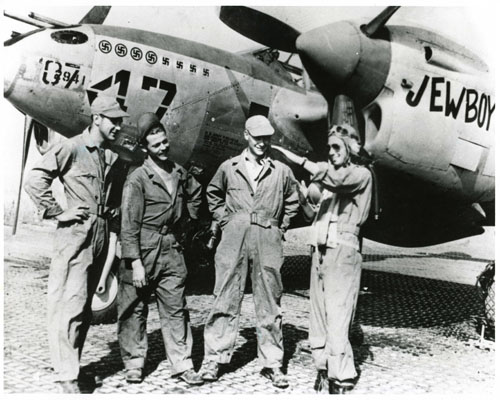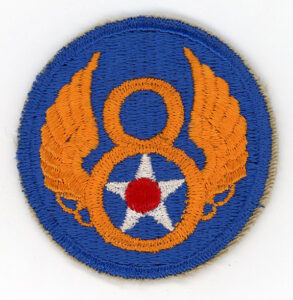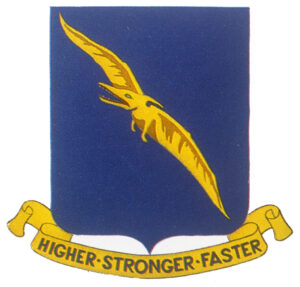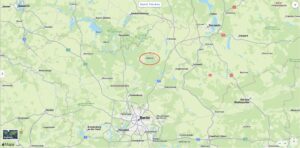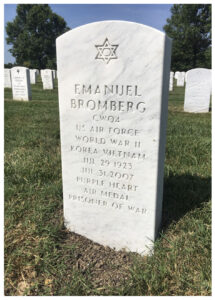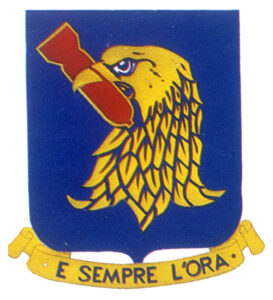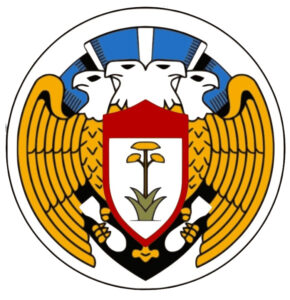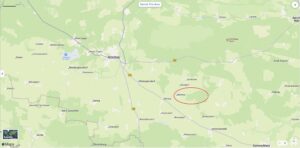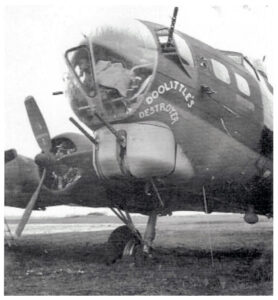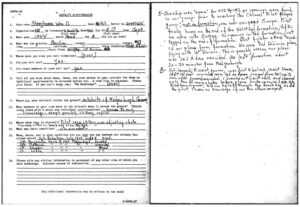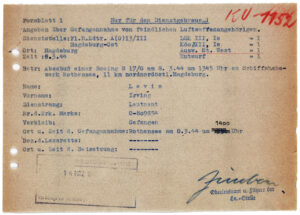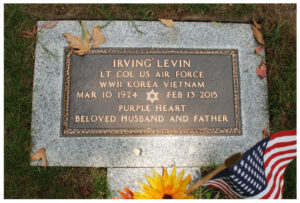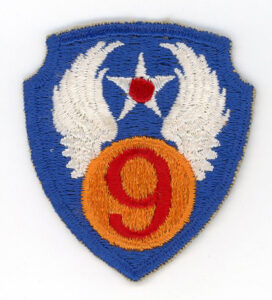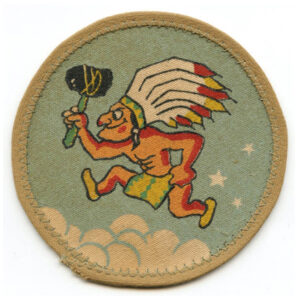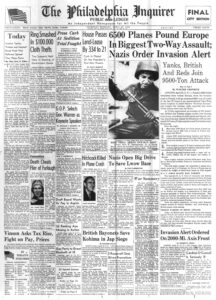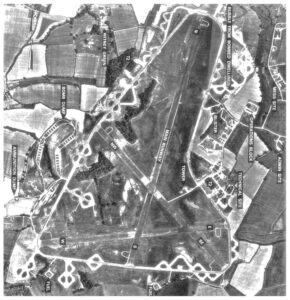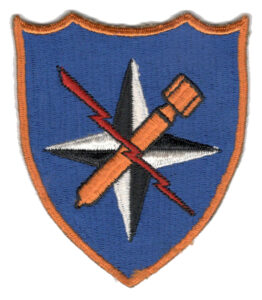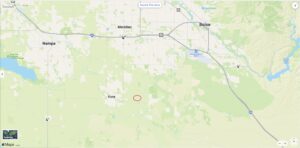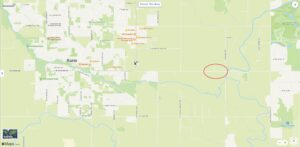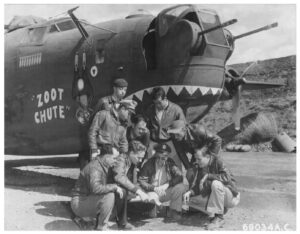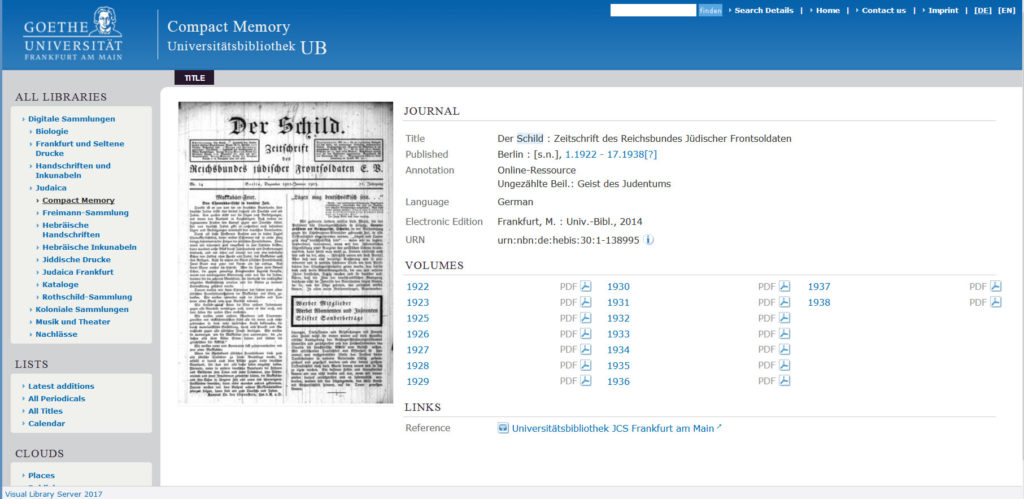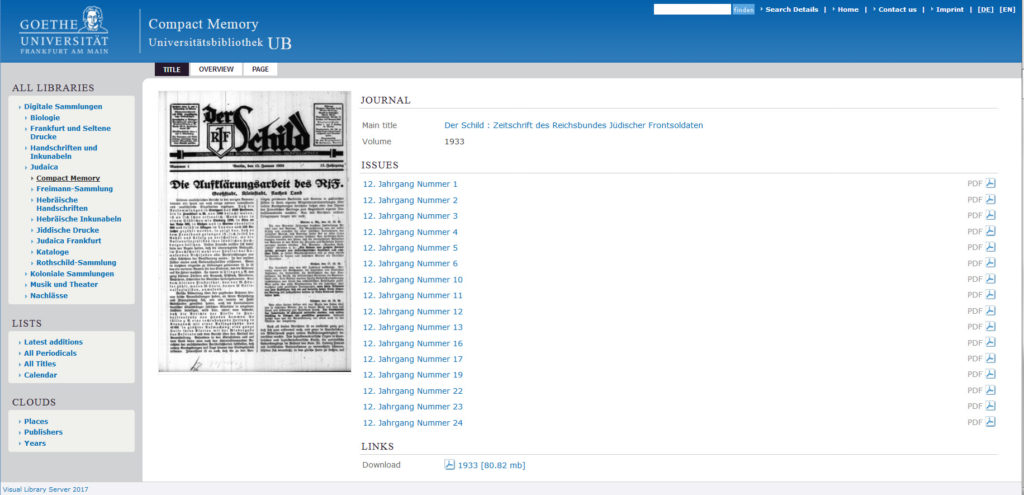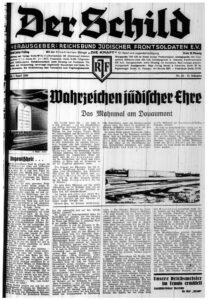My recent posts about Jewish military casualties and participation in World War Two have been centered upon the date of March 8, 1944, based on a news article in The New York Times that reported on the death in combat – on that date – of Second Lieutenant Jesse H. Lack, a navigator who served in the 8th Air Forces’ 458th Bomb Group. Other posts related to that date present biographical information about Jacob “Jack” Moskowitz of the 452nd Bomb Group, and Milton W. Stern of the 381st Bomb Group, who became prisoners of war of the Germans under dramatically different circumstances, spending the remainder of the war as inadvertent “guests” of their captors in Stalag Luft I. And, Second Lieutenant Daniel S. Rothenberg and Squadron Leader David A. Goldberg, fighter pilots in the United States Army Air Force, and, Royal Canadian Air Force, respectively.
Another post pertaining to this date – of much greater brevity – pertains to Jewish soldiers in the ground forces of the Allies
And so, we now come to this “last” (for now?) post related to Jewish military service on March 8, 1944: Following the same general format as I’ve previously established, here are biographical profiles (and sometimes even more) about other Jewish aviators in the Allied armed forces who were casualties or otherwise on this day. Some did not return. Others, did.
Their names and very brief stories follow…
For those who lost their lives on this date…
Wednesday, March 8, 1944 / 14 Adar 5704
– .ת.נ.צ.ב.ה. –
…Tehé Nafshó Tzrurá Bitzrór Haḥayím
May his soul be bound up in the bond of everlasting life.
~~~~~~~~~~~~~~~~~~~~~~~~~~~~~~
United States Army Air Force
8th Air Force
~~~~~~~~~~~~~~~~~~~~
~~~~~~~~~~~~~~~~~~~
Sgt. Emanuel Bromberg, 13153157, Riverside, N.J. – Prisoner of War
This is the insignia of the 92nd Bomb Group, via the American Air Museum in Britain (image FRE 5075)…
…and, from Flying Tiger Antiques, this is the emblem of the 327th Bomb Squadron.
B-17G Flying Fortress 42-31772 of the 92nd Bomb Group’s 407th Bomb Squadron, during the Group’s mission to Berlin, was last reported – albeit not definitely – turning away from the 92nd’s formation and jettisoning its bombs. piloted by 2 Lt. Walter F. Payne, the bomber’s last position doesn’t seem (?) to have been marked upon the map included in Missing Air Crew Report 2995, which documents the plane’s loss. (At least, going by Fold3’s fuzzily-scanned-microfiche version available via the National Archives.) However, the MACR’s main data sheet lists the coordinates where the plane was last seen as 53-00 N, 13-40 E … about 45 miles north-northeast of Berlin. According to the American Air Museum in Britain, the plane crashed near Templin, which is 40 miles (almost) due north of the German capital city. That’s the only record of the aircraft’s fate, as Luftgaukommando Report KU 1191 only comprises a solitary dog-tag: That of right waist gunner S/Sgt. Thomas M. Farrell, Jr. Paralleling this, Missing Air Crew Report 2995 simply includes a transcript of the information embossed onto S/Sgt. Farrell’s dog-tag.
This map shows the location of Templin, relative to Berlin.
As for the B-17s squadron code letter and nickname (if any), these are unknown.
Pilot: Payne, Walter E., 2 Lt., 0-679112 – Piedmont, S.C.
Co-Pilot: Quarter, Gerald L., 2 Lt., 0-687633 – Tuscon, Az.
Navigator: McDowell, William, Jr., 2 Lt., 0-691774 – Niagara Falls, N.Y.
Bombardier: Jenkins, Edward T., 2 Lt., 0-682547 – Summerville, S.C.
Flight Engineer: Rawlings, Vernon Keith, S/Sgt., 38183480 – Wanette, Ok.
Radio Operator: Bannow, Thomas E., S/Sgt., 16154468 – Marinette, Wi.
Gunner (Ball Turret): Hallam, Arthur E., Sgt., 11111800 – Providence, R.I.
Gunner (Right Waist): Farrell, Thomas M., Jr., S/Sgt., 15116362 – Denver, Co.
Gunner (Left Waist): Bromberg, Emanuel, Sgt., 13153157 – Riverside, N.J.
Gunner (Tail): Phipps, Harvey., Jr., Sgt., 35580341 – Indianapolis, In.
Sergeant Emanuel Bromberg, the bomber’s left waist gunner, was born in Riverhead (Long Island), New York, on July 23, 1923. The son of Joseph and Ada Bromberg, his family resided at 225 Pavillion Ave. in Riverside, New Jersey, though an additional address was 550 Cinnaminson Ave. in Palmyra (also-New-Jersey). He was imprisoned at Stalag Luft IV, and like all his fellow crewmen, eventually returned to the United States.
His name appeared in the Philadelphia Inquirer on April 29 (in the Philadelphia Record on that date and May 12) and June 8, 1944, and in a list of liberated POWs published on May 14, 1945. His name can also be found on page 228 of American Jews in World War II, accompanied by the notation that he received the Purple Heart, albeit with no mention of the Air Medal or Oak Leaf Clusters. Thus, he’d flown less than five combat missions prior to being shot down.
He died on July 31, 2007, just after his 84th birthday, and is buried at Arlington National Cemetery: Section 64, Site 5260. He evidently made the military a career, as his matzeva lists service in Korea and Vietnam, retiring at the rank of CWO4 (Chief Warrant Officer Grade CW-4).
This image of CWO4 Bromberg’s matzeva is by FindAGrave contributor Ricky Woods.
~~~~~~~~~~~~~~~~~~~
2 Lt. Homer Previn Landau, 0-809644, Pittsburgh, Pa. – Killed in Action
The motto of the 96th Bomb Group, “E Sempre l’Ora”, means “And Always Now”. This image of the group’s insignia is from the American Air Museum in Britain (“FRE 5092”)…
…while this depiction of a winged snake carrying a bomb, the insignia of the 339th Bomb Squadron, is from RedBubble.com.
 While information about United States Army Air Force WW II combat casualties might initially be thought of in terms of Missing Air Crew Reports, there were, alas, many circumstances throughout the war for which that set of records was neither bureaucratically “filed” nor informationally relevant. The death of 2 Lt. Homer Previn Landau (0-809644), a navigator assigned to the 339th Bomb Squadron of the 96th Bomb Group, is one such instance. His aircraft, B-17G Flying Fortress 42-31657 (otherwise known as “Wildfire II” / “QJ *S“), returned to its base at Snetterton, England, despite being damaged by a 20mm shells fired by attacking German fighters. Lt. Landau, struck by one of these projectiles, did not survive his injuries. He is buried at the Cambridge American Cemetery in England, at Plot F Row 6 Grave 94.
While information about United States Army Air Force WW II combat casualties might initially be thought of in terms of Missing Air Crew Reports, there were, alas, many circumstances throughout the war for which that set of records was neither bureaucratically “filed” nor informationally relevant. The death of 2 Lt. Homer Previn Landau (0-809644), a navigator assigned to the 339th Bomb Squadron of the 96th Bomb Group, is one such instance. His aircraft, B-17G Flying Fortress 42-31657 (otherwise known as “Wildfire II” / “QJ *S“), returned to its base at Snetterton, England, despite being damaged by a 20mm shells fired by attacking German fighters. Lt. Landau, struck by one of these projectiles, did not survive his injuries. He is buried at the Cambridge American Cemetery in England, at Plot F Row 6 Grave 94.
Born in Pittsburgh, Pa., on October 27, 1915, at the age of 29 he was notably older that most of his fellow combat flyers. He was the son of Saul Albert (4/15/89-11/3/51) and Bessie (Previn) (10/26/92-?) Landau, his family residing at 6558 Bartlett Street in the city of his birth. A news article about his death was published in the Pittsburgh Press on April 3, 1944, and his name (only his name, and nothing more) can be found in the September 7, 1945, issue of Pittsburgh’s Jewish Criterion, which commemorated Jews from that city who were killed in the (by then) just-concluded-war. His name also appears on Page 534 of Volume II of American Jews in World War II, which records that he received the Purple Heart, Air Medal, and one Oak Leaf Cluster, thus indicating that he completed between 5 and 10 combat missions.
~~~~~~~~~~~~~~~~~~~~
T/Sgt. George B. Silverman, 31153017 – Portland, Me.
T/Sgt. Milton Scharf, 12188872 – Brooklyn, N.Y.
Prisoners of War
This image of the insignia of the 100th Bomb Group was uploaded to WW 2 History Fandom by Fargo84.
…while this image of the emblem of the 315st Bomb Squadron was found at EBay Australia.
The entire crew of First Lieutenant Norman Lester Chapman survived the loss of their bomber during the 100th Bomb Group’s mission to Berlin. There are three brief accounts in Missing Air Crew Report 3032 describing the loss of their plane, B-17G 42-40056, otherwise and perhaps better known as “Holy Terror III” (or was it “Katie’s Boys“?). Two follow:
First… “Lt. Chapman feathered one engine, then unfeathered it near Dumer Lake at about 1240 hours. He continued the formation, although straggling, to the I.P. where three enemy fighters attacked him. Our escort went down and picked him up. His A/C was under control when last seen.”
Second… “Lt. Chapman, flying lead, 2nd element, high squadron, lagged at 1357 hours near 51-50 N 10-54 E. No. 1 engine was feathered and then unfeathered.”
Like many (definitely not all) MACRs for USAAF aircraft lost in the European Theater of War, MACR 3032 includes a translation from the relevant Luftgaukommando Report – in this case, KU 1153 – which pinpoints the location where the B-17 crashed: 9.5 kilometers east-south-east of Jueterbog in the Sernower heath, or, 1 kilometer “south of the field path Froehden-Schlenzer”. Time: 1345 hours. There wasn’t much left of the B-17; it’s described as 95% burnt out, albeit this Luftgaukommando Report’s description of the bomber’s wreckage is extremely detailed, comprising two pages of technical information.
This map shows the location of Sernow (thus, the “Sernower Heath” would be nearby?) relative to Juterbog. As to the “field path Froehden-Schlenzer””, I have no idea.
Given the final condition of the aircraft yet the fortunate survival of its entire crew, all the men presumably parachuted from the plane. The crew was comprised of:
Pilot: Chapman, Norman Lester, 1 Lt., 0-746292 – Hillsborough (Hillsborough), N.H. (11/11/18-12/18/98)
Co-Pilot: Ellis, Rex Monroe, 2 Lt., 0-752187 – Ks. (2/2/20-1/16/03)
Navigator: Lindbom, Glenn G., 2 Lt., 0-809659 – Ishpeming, Mi.
Bombardier: Clark, Wilson D., 2 Lt., 0-750274 – Seattle, Wa.
Flight Engineer: Silverman, George B., T/Sgt., 31153017 – Portland, Me.
Radio Operator: Scharf, Milton, T/Sgt., 12188872 – Brooklyn, N.Y.
Gunner (Ball Turret): Hutchings, Durward E., S/Sgt., 12171577 – Hudson, N.Y.
Gunner (Right Waist): Yzenas, Frank A., S/Sgt., 12161945 – Dickson City, Pa.
Gunner (Left Waist): Hill, Leon Earnest, S/Sgt., 38273822 – Ok. (11/25/09-11/1/93)
Gunner (Tail): Dobbs, George E., S/Sgt., 39406131 – Sacramento, Ca.
Like every man in the crew, Technical Sergeant’s Milton Scharf and George Barnett Silverman survived the war as POWs; the former at Stalag Luft IV (Gross-Tychow), and the latter at Stalag Luft III and subsequently Stalag VIIA (Moosburg).
T/Sgt. Milton Scharf, the plane’s radio operator, born in Brooklyn on December 29, 1922, was the son of Nathan and Evelyn Scharf, his family residing at 8909 Avenue B in that borough. His name appears on page 428 of American Jews in World War Two, which records that he received the Air Medal and two Oak Leaf Clusters. In the news media (in the fleeting era when the United States actually had what passed for an actual news media), his name appeared in War Department Casualty Lists published on 4/29/44, 5/19/44, and 6/6/45, the last being a list of liberated POWs. He died on November 21, 2004, and is buried in Pflugerville, Texas.
As evident in many of my prior posts, the names of many American Jewish WW II servicemen, whether decorated or casualties, never appeared in the 1947 compilation American Jews in World War II. George Barnett Silverman (31153017), the bomber’s flight engineer, is one such example; his name is absent from that volume Born in South Portland, Maine, on September 9, 1921, he was the son of William S. (5/30/76-12/14/62) and Harriet (Israelon) (1898-9/29/40) Silverman, his family residing at 335 Cumberland Street in Portland. He was the husband of Marge L. (Kelley) Silverman (9/4/22-3/3/06), whose wartime address was 95 Smith Street in Portland. Mr. Silverman passed away on July 2, 1991, and is buried alongside his wife at Evergreen Cemetery in Portland. He was (at least) awarded the Air Medal, as indicated by the following article from the Portland Press-Herald of February 15, 1944.
~~~~~~~~~~~~~~~~~~~~
2 Lt. John Monroe Chapman, Jr., 2 Lt., 0-678165, Birmingham, Al. – Prisoner of War
We’ve just encountered First Lieutenant Norman Lester Chapman. Another “Chapman” who became a prisoner of war on March 8, 1944, was Second Lieutenant John M. Chapman, Jr. (0-678165), a co-pilot in the 303rd Bomb Group’s 360th Bomb Squadron.
The emblem of the 303rd Bomb Group’s 360th Bomb Squadron. It’s image UPL 14815 from the American Air Museum in Britain.
During the 303rd Bomb Group’s mission to Berlin, B-17G 42-31471, “DOOLITTLE’S DESTROYER“, was – according to Missing Air Crew Report 2908 – last seen “apparently under control” but descending very rapidly in the vicinity of Brandenburg, Germany. Luftgaukommando Report KU 1156 gives four locations for the plane’s crash: 1) “…north of Althaldonsleben, 20 kilometers northwest of Magdeburg”, 2) “Near the ships elevator yard at Rothensee”, 3) “2 kilometers northeast of Magdeburg”, and 4) “2 kilometers southeast of Neu Haldensleben”.
This map shows the general location of Rothensee, a district of Magdeburg. This is also the crash location of B-17G 42-97525 “Invictus” of the 452nd Bomb Group (see below).
This image of DOOLITTLE’S DESTROYER (“stuck in the mud”) is from the 303rd Bomb Group (c/o the Richard A. Lund Family).
Identical to Lt. Chapman’s crew, the ten men aboard 42-31471 also safely parachuted and survived as POWs. They were:
Pilot: McGrath, Leo B., 2 Lt., 0-738444 – Oxnard, Ca.
Co-Pilot: Chapman, John Monroe, Jr., 2 Lt., 0-678165 – Birmingham, Al.
Navigator: Volk, Anthony D., 2 Lt., 0-676183 – Philadelphia, Pa. (5/13/20-2/16/19)
Bombardier: Klasnick, Joseph S., S/Sgt., 13040917 – Pittsburgh, Pa. (4/14/16-11/1/78)
Flight Engineer: Green, Jack E., S/Sgt., 18129763 – Muskogee, Ok.
Radio Operator: Bonn, Charles J., S/Sgt., 12092994 – Union City, N.J. (2/7/23-4/19/97)
Gunner (Ball Turret): Mayfield, James E., S/Sgt., 34397454 – Elrod, Al.
Gunner (Right Waist): Hosso, Harry V., S/Sgt., 15323137 – Martins Ferry, Oh. (1/7/22-3/28/10)
Gunner (Left Waist): Tharp, Wallace L., S/Sgt., 6574982 – Colorado Springs, Ca. (8/21/21/-1/21/15)
Gunner (Tail): Laible, Gilbert N., S/Sgt., 19146806 – Fallbrook, Ca.
As for Lieutenant Chapman? He was born in Birmingham, Alabama, on December 29, 1921, the son of John Monroe (Sr.) and Allene R. Chapman, who resided at 3809 12th Court South in that city; his siblings were Donald and Ruth. He was interned in North Compound 1 of Stalag Luft I. Though he was identified by the National Jewish Welfare Board as being a Jew – in the organization’s quest to chronicle Jewish military service, and, provide religious and spiritual fellowship as well as practical aid to Jewish servicemen in all theaters of war – and was recorded as such in the NJWB’s files (which denote the award of the Air Medal and two Oak Leaf Clusters), his name never appeared in American Jews in World War II. He died at the age of 63 on April 25, 1985, and like CWO4 Bromberg, also made the military a career: He is buried in Arlington National Cemetery (Section 8, Site 161-LH), his matzeva listing his rank as Colonel and bearing the symbol of a Command Pilot Badge.
This image of the matzeva of Colonel John M. Chapmani, Jr., is by FindAGrave contributor John Evans.
~~~~~~~~~~~~~~~~~~~~
2 Lt. Alfred Hano, 0-679504, New York, N.Y. – Killed in Action
Sgt. Louis Markson, 32738252, Jeffersonville, N.Y. – Prisoner of War
This is the emblem of the 388th Bomb Group – “Fortress for Freedom” – from US Wars Patches….
…and this is the emblem of the 560th Bomb Squadron.
The fate of the ten airmen aboard B-17G 42-37819 (alias “Jimmy Lee” / “P“) of the 388th Bomb Group’s 560th Bomb Squadron was, alas, unlike that of the Chapman and McGrath crews: Only six members of the crew survived. Missing Air Crew Report 3087 includes only one terse observation of the bomber’s loss: “A/C #819 flying second element lead of the low squadron dove out of formation as a result of e/a attacks. 4 chutes in the area at the time could not be definitely identified as having come from this A/C.” However, the master roster of Luftgaukommando Reports (this one being KU 1182) lists the plane’s crash location as Heppenhorst-Mieste, near Gardelegen, while the single translated sheet from KU 1182 in the MACR lists the location as “Mieste (Miester forest), 25 kilometers northwest of airfield Helmstedt”.
These two maps show the location of Mieste relative to Gardelegen.
Here’s a closer view…
Of course, more important than the plane was the crew within it, whose names are listed below. As can be seen, six of the ten – all NCOs – survived. The crew comprised:
Pilot: Tobias, Leonard Travis “Toby”, 1 Lt., 0-799506 – Montgomery, Al. – (10/3/21) KIA
Co-Pilot: Yurkutat, Walter Edward, 2 Lt., 0-747941 – Newark, N.J. – (3/27/20) KIA
Navigator: Gotha, Herbert Joseph, 2 Lt., 0-808037 – Paxton, Ma. – (7/27/20) KIA
Bombardier: Hano, Alfred, 2 Lt., 0-679504 – New York, N.Y. – KIA
Flight Engineer: Eldridge, Raymond W., T/Sgt., 32490041 – Hoosic Falls (?), N.Y.
Radio Operator: McIntyre, Neal W., Jr., T/Sgt., 14140622 – Fitzgerald, Ga.
Gunner (Ball Turret): Albers, Frederick R., S/Sgt., 32507698 – N.Y.
Gunner (Right Waist): Pikor, Joseph, Jr., S/Sgt., 33301162 – Pa. (1921-12/10/60)
Gunner (Left Waist): Markson, Louis, Sgt., 32738252 – Jeffersonville, N.Y. (4/20/17-11/12/04)
Gunner (Tail): Filipowski, John J., S/Sgt., 33292846 – Braddock, Pa. (5/29/21-8/14/04)
Though no single Casualty Questionnaire returned to the Army by the any of the six survivors recounts the entirety of the bomber’s loss in comprehensive, complete, essay-like detail, the brief records that do exist reveal that the bomber broke in half at the radio room while under attack by German fighters – structural damage? – explosion? – both? – with the men in the rear (even the ball turret gunner) parachuting from the tail section, and the flight engineer from the front. Lieutenants Tobias and Yurkutat were – alas – trapped in their seats … and were seen in the wreckage of the nose section afterwards. What happened to Lieutenants Hano and Gotha will by now, in 2024, doubtless never really be known. Hano definitely left the plane – his body was seen near the wreckage by survivors – but how he died is unknown. It was suggested that his parachute failed, or he was killed after landing under unknown circumstances, as Sgt. McIntrye heard a shot nearby upon reached the ground. As reported in the MACR, there is no real information about what happened to Lieutenant Gotha.
Or, as described by Sergeant Markson (whose Casualty Questionnaire appears below this quote):
The plane broke or blew up at the radio room. I was thrown out of plane.
The reason for my answer of No Knowledge [for Casualty Questionnaires] is the I had flown with the crew on my first mission. After I was taken prisoner and sent to interrogation camp and then to permanent camp in Germany I met up with
Fred Albers (EM)
Joseph Pikor (EM)
John Filopowski [sic] (EM)
“ McIntyre (EM)
What happened to the remainder of the crew is unknown to me. The above mentioned men could probably give more information than I for they had been together longer.
Born in Jeffersonville, New York, on May 20, 1917, Sergeant Louis Markson (Hebrew name Eliezer ben Yisrael) was the son of Irving (5/5/92-?) and Lillian (Davis) (9/10/85-11/26/67) Markson (originally “Markowsky”), and the brother of Philip, his family residing in that upstate village which is northwest of Monticello. His name appeared in the Sullivan County Record on March 30 and April 27 of 1944, and, the Hancock Herald on April 6 and May 4 of that same year, but, not in American Jews in World War II. Like Sgt. Bromberg, he spent the remainder of the war at Stalag Luft IV. He passed away at the age of 87 on November 12, 2004, and is buried at Temple Sinai Cemetery in Circleville, N.Y., a hamlet southeast of Monticello.
These images of his matzeva, and, military grave marker, are by FindAGrave contributor Suzanne.
Lieutenant Hano, born in Manhattan on October 8, 1918, was the son of Alfred Barnard Hano, Sr. (6/30/90-5/15/67) and Clara (Millhauser) Hano (9/8/90-12/9/53), who resided at 124 East 24th St., in Manhattan. He was married; his wife was Beth Marguerite (Singer) Hano (12/24/24-4/16/94) the couple residing at 170 West 74th St. in New York City. He’s buried at Temple Israel Cemetery (Mount Hope Cemetery), Hastings-on-Hudson, N.Y., his biography at FindAGrave having much (albeit not exactly) the same information as appearing in this blog post. His name appeared in a Casualty List published in The New York Times on April 23, 1944, and can also be found on page 341 of American Jews in World War II, which lists him as having received the Air Medal with three Oak Leaf Clusters, and (of course) the Purple Heart.
Pilot: Tobias, Leonard Travis “Toby”, 1 Lt., 0-799506 – Montgomery, Al. – (10/3/21) KIA
Co-Pilot: Yurkutat, Walter Edward, 2 Lt., 0-747941 – Newark, N.J. – (3/27/20) KIA
Navigator: Gotha, Herbert Joseph, 2 Lt., 0-808037 – Paxton, Ma. – (7/27/20) KIA
Bombardier: Hano, Alfred, 2 Lt., 0-679504 – New York, N.Y. – KIA
Flight Engineer: Eldridge, Raymond W., T/Sgt., 32490041 – Hoosic Falls (?), N.Y.
Radio Operator: McIntyre, Neal W., Jr., T/Sgt., 14140622 – Fitzgerald, Ga.
Gunner (Ball Turret): Albers, Frederick R., S/Sgt., 32507698 – N.Y.
Gunner (Right Waist): Pikor, Joseph, Jr., S/Sgt., 33301162 – Pa. (1921-12/10/60)
Gunner (Left Waist): Markson, Louis, Sgt., 32738252 – Jeffersonville, N.Y. (4/20/17-11/12/04)
Gunner (Tail): Filipowski, John J., S/Sgt., 33292846 – Braddock, Pa. (5/29/21-8/14/04)
~~~~~~~~~~~~~~~~~~~~
2 Lt. Irving Levin, 0-809654, Brooklyn, N.Y. – Prisoner of War
“Labor Ad Futurum” – “Work for the Future”: The emblem of the 452nd Bomb Group, via … the American Air Museum in Britain…
…and the emblem of the 730th Bomb Squadron, also from the AAMiB.
Like the other Flying Fortress losses described on this page, the fate of aircraft 42-97525 “Invictus” of the 452nd Bomb Group’s 730th Bomb Squadron – piloted by 1 Lt. Frank S. Stephens – also entailed uncertainty and ambiguity; at least, as recorded in Missing Air Crew Report 3195. This is limited to the anonymous statement: “No information concerning loss of this aircraft has been reported.” The reason for the apparent mystery behind the bomber’s loss is revealed in the postwar Casualty Questionnaire filled out by (former) left waist gunner, William D. Strayhorn:
Our ship was “spare” for 452 Gp. (H.) no openings were found in our group prior to reaching the Channel. Pilot followed group; not in formation, on over occupied Europe. Pilot finally hung on the end of the 401st Gp’s formation; After we were over Europe – no opening in the formation, just tagged on the end of formation. First fighter attack knocked our plane from formation. We were 3rd Division plane, flying with 1st Division. This is possible reason our plane, was said to have vanished. We left formation about 20 – 30 minutes from Madgenburgh. [sic]
Sgt. Leonard, R. Waist gunner, was first to bail out. Waist Door left (4) four wounded men, Sgt. LaFrance jumped from tail exit, only two (2) more chutes before plane broke up in mid air. Sgt. Robertson, engineer, told me he left through the bomb bay, as did the pilot. I have no knowledge of ou [sic] the others escaped.
According to English-language translations from Luftgaukommando Report KU 1152 within this MACR, Invictus crashed “Near the ships elevator yard at Rothensee, 11 km north-northeast / 11 km northeast of Magdeburg.”
This map shows the general location of Rothensee, which is also the crash location of B-17G 42-31471 “DOOLITTLE’S DESTROYER” of the 303rd Bomb Group (see above).
The plane’s crew comprised:
Pilot: Stephens, Frank S., 1 Lt., 0-746455 – Tulsa, Ok.
Co-Pilot: Mary, William Henry “Bill”, Jr., 2 Lt., 0-751749 – Knoxville, Tn. – (Born 6/21/20) KIA
Navigator: Levin, Irving, 2 Lt., 0-809654 – Brooklyn, N.Y.
Bombardier: Kloepfer, Leon Ralph, 2 Lt., 0-747023 – Los Angeles, Ca.
Flight Engineer: Robertson, Benjamin W., S/Sgt., 13066222 – Plymouth, N.C. (1/21/23-12/16/97)
Radio Operator: Benjamin, Floyd Thomas, S/Sgt., 19170290 – Portland, Or. (10/13/24-2/7/02)
Gunner (Ball Turret): Matthews, Earl F., S/Sgt., 15066165 – Ky.
Gunner (Right Waist): Leonard, James F., Sgt., 3334282 – Philadelphia, Pa.
Gunner (Left Waist): Strayhorn, William David, Pvt., 20447605 – Wilmington, N.C. (3/13/21-1/7/94)
Gunner (Tail): LaFrance, Joseph F., Sgt., 11007294 – New Bedford, Ma. (1/17/21-3/22/08)
Though his name appears on a “Report of Capture of members of enemy air forces” sheet within the Luftgaukommando Report, Casualty Questionnaires in the MACR (only a few crewmen completed and returned these documents) offer no definitive information about the sole casualty among the crew, co-pilot 2 Lt. William H. Mary. The general impression seems to have been that he was believed to be leaving the aircraft at the same time as the pilot, and may have been wounded by still-attacking fighters and unable to leave the aircraft, which – as described by William Strayhorn – broke apart in mid-air, with the bombs still aboard. In any event, the search for Lt. Mary was recorded as SD Case 5763.Lorraine Postwar, he was buried at the American Cemetery and Memorial in Lorraine, France, while a commemorative stone in his honor was emplaced between the tombstones of his parents at Knoxville, Tn.
The plane’s navigator, 2 Lt. Irving Levin, was born – probably in New York – on March 10, 1924, to Ben (4/25/92-3/31/44) and Mamie (Seplowitz) (1/99-11/15/81) Levin; he had a sister, Leah (12/19/29-12/29/13). The family possibly resided at 2373 85th Street, in Brooklyn. Contemporary records also list a relative or friend as a Mr. Jack Betts, of 2019 80th St., Brooklyn, N.Y.
Lt. Levin was imprisoned at Stalag Luft III and Stalag VIIA. His name can be found on page 376 of American Jews in World War II, which records that he received the Bronze Star and Purple Heart, thus indicating that he completed less than five combat missions, and, was wounded. His name also appeared in a Casualty List (of liberated POWs) published on June 10, 1945.
Here’s the document (the only such document) in Luftgaukommando Report KU 1152 pertaining to his capture: an “Angaben über Gefangennahme von feindlichen Luftwaffenangehörigen. (Nur für den Dienstgebrauch!)” form. That is, “Information on capture of enemy air force personnel.” (For official use only!)”
Continuing a pattern unknown to me when I started work on this post, it was discovered that Lt. Levin – like Sgt. Bromberg and Lt. Chapman – despite the impact of having been shot down and made a prisoner of war – nonetheless made military service a postwar career, which is described at his FindAGrave biographical profile. He passed away on February 13, 2015, and is buried at Arlington National Cemetery.
This portrait, provided to FindAGrave by Mark Schreiner, shows him postwar…
…while this image (via Mary D) shows his matzeva at Hillside Cemetery, Issaquah, Washington.
~~~~~~~~~~~~~~~~~~~~
Sgt. Manfred “Manny” Stein, 13122870, Glendale, N.Y. – Wounded in Action
Though the Group emblem of the 466th Bomb Group seems to be unavailable via the Internet, the 785th Squadron’s insignia is, via the American Air Museum in Britain. Here it is:
Somewhat paralleling the profile of Lt. Landau (at the “top” of this post) – well, in terms of “information”, there’s no Missing Air Crew Report pertaining to Sergeant Manfred “Manny” Stein (13122870), precisely because – having been wounded – he and his crew safely returned to the 466th Bomb Group’s base at Attlebridge, England. (There might be information about him in historical records of the 785th Bomb Squadron, but I haven’t checked. He was identified as having been a member of the 785th via the American Air Museum in Britain.)
As described in a news article in the Long Island Star Journal of May 23, 1944 (he was earlier mentioned in that newspaper on October 7, 1943), the sergeant – a waist gunner – was severely wounded when he was struck in his left ankle by shrapnel from a cannon shell. His name also appeared (without elaboration) in Casualty Lists published in the Ridgewood Times on 5/26/44, and Long Island Daily Press on 5/23/44. Here’s the latter (via FultonHistory.com), followed by a transcript:
Stein, Aerial Gunner, Hit by Nazi Bullet
Sergeant Manfred Stein, 22-year-old aerial gunner, of Glendale, was wounded in the ankle when a German plane fired at his Liberator.
“One plane that we didn’t see started to fire at us,” he wrote to his mother, Mrs. Bertha Stein of 65-02 Catalpha Avenue. “A shell hit the plane and exploded. Several pieces of shrapnel entered my ankle.”
Unaware that his family had been notified of his injuries received on March 8 over Germany, the winner of the Air Medal and Purple Heart had not mentioned them in his letters home.
Sergeant Stein was born in the Bronx and attended Newtown High School and National Youth Administration Aviation Mechanics School in Maine. Before entering the service in September, 1942, he was employed as an aviation mechanic in Middletown, Pa.
After his training in Columbus, Ohio, and New Mexico, he went overseas in February of this year. His sisters, Mrs. Solomon Bromberg and Beatrice Stein, live with his mother in Glendale.
Born in the Bronx on November 19, 1921, he was the son of William (4/17/82-5/13/33) and Bertha Jenny (Loeb) (7/20/84-7/13/77) Stein. His name appears on page 454 of American Jews in World War II, which records him as having been awarded the Air Medal and Purple Heart. You can learn even more about his life at Legacy.com.
He passed away on January 6, 2014, and is buried at Middletown Cemetery, Middletown, Pennsylvania.
~~~~~~~~~~~~~~~~~~~~~~~~~~~~~~
9th Air Force
~~~~~~~~~~~~~~~~~~~~
Sgt. Harry Bear, 33104592, Philadelphia, Pa. – Killed Non-Battle
I can’t find an example of the insignia of the 387th Bomb Group, but…
…here’s the insignia of the 556th Bomb Squadron, from Flying Tiger Antiques.
Some years back, in March of 2009 (seems “just yesterday” … a world nearly unrecognizable from the hindsight of 2024) I was browsing through military and aviation magazines on display at a Borders Books and Music. (Remember Borders, a p h y s i c a l book and music store?) By chance; by luck, I came across the most recent issue of Key.Aero’s FlyPast magazine, the cover of which displayed an image of a restored (early version?) B-26 Marauder in flight. “A B-26 on the cover. Must be something about the B-26 inside.” And so there was. Within, on pages 40 through 45, appeared the article “‘Double Trouble’s’ Destiny” by Alan F. Crouchman. I flipped through the pages, illustrated with a variety photos of 387th Bomb Group B-26s, air crews, and personnel. some undoubtedly from private collections. A particular, full-size-page image stood out: a picture credited to the Army Air Force, of a Sergeant Harry Bear kissing a rabbit’s foot. Then, I remembered: I knew that name, H a r r y B e a r. I came across it before: while reviewing wartime issues of the Philadelphia Inquirer, in 35mm microfilm…
First, an article about Harry Bear was published on April 20, 1944, as the “lead” article in a Casualty List released that day…
“Page 1”
The article…
Death Cheats Flier of Furlough
With only one more combat mission to go before his furlough, Sergeant Harry Bear, engineer-gunner on the Marauder “Doghouse II,” took off from a Ninth Air Force Medium Bomber Station March 8 on a sortie over enemy territory – and failed to come back.
In a War Department telegram received by his mother, Mrs. Rose Bear, 5352 Jackson St., Sergeant Bear was reported to have been killed in action over Europe.
The 24-year-old airman was holder of the Distinguished Flying Cross and the Air Medal with five Oak Leaf Clusters “for conspicuous gallantry.”
A graduate of Overbrook High School, he worked at the Philadelphia Navy Yard prior to his enlistment.
…his portrait, probably sent from England to the Baer family, or snipped from a crew photo…
…and, the August 1, 1948 issue of the Inquirer, in a very brief funeral announcement.
Born in Philadelphia on May 23, 1920, Sergeant Harry Bear (33104592) was the son of Frank Harry (7/15/89-12/22/84) and Rose (Ludfinski) (2/12/98-1/17/71) Bear, and the brother of Edith (1925-12/24/10) and Sally (1923-10/03). The family resided at 5352 (5253?) Jackson Street or (?) 1210 South 49th Street in that city. Along with the two news items above, his name appeared in a brief obituary published in the Jewish Exponent on August 6, 1948. However, unlike some of the airmen mentioned in this post, his name did appear in American Jews in World War II: it’s on page 510, with mention of his having been awarded the Distinguished Flying Cross, Air Medal, five Oak Leaf Clusters, and Purple Heart.
When I checked the name index to the Missing Air Crew Reports, I found that the index card for Sgt. Bear bore no MACR number. Thus, no MACR covering the incident in which he was killed, was ever filed. However, unlike the vast majority of MACR name index cards, this one is specific, for it bears a calendar date in the notation: “KIA March 8, 1944 EA” – which corroborated the Inquirer news article. It was only some years later, with the advent of the 387th Bomb Group’s website, that the story of Sgt. Bear and his fellow crew members was revealed: There was a mid-air collision between two B-26s over the Group’s base at Chipping Ongar, England, involving the loss of Bear’s B-26, “DOUBLE TROUBLE” (B-26B 41-31684, otherwise known as “FW * A”), and the fortunate survival of the other (damaged) B-26 … “Itsy-Bitsy” (B-26B 41-31679, “FW * K“), which was so badly damaged as to eventuate in its salvage, albeit its entre crew survived.
The crew of DOUBLE TROUBLE…
Pilot: Sargent, Edward Doyle, 1 Lt., 0-662675 – 11/7/17, Richland County, Oh.
Co-Pilot: Ogden, Donald Lloyd, 2 Lt., 0-672859 – 9/10/20, Gaylord, Mi.
Bombardier / Navigator: Levi, Alexander W. – 0-732868 (Member of 557th Bomb Squadron)
Flight Engineer: Simoski, Joseph E., S/Sgt. – 11018324 – Middlesex County, Ma.
Radio Operator: Nordlohne, Robert Alexander, T/Sgt., 35453740 – 8/25/18, Covington, Ky.
Gunner: Bear, Harry, S/Sgt.
The (partial) crew of Itsy-Bitsy…
Pilot: Ayer, Sam, 2 Lt.
Co-Pilot: Bartley, Houston N., 1 Lt.
Bombardier: Leonard, Ray E., 2 Lt.
Alan Crouchman’s FlyPast article about the 387th includes a very detailed account of the loss of DOUBLE TROUBLE, which, given the specificity therein, is probably based on the Accident Report filed for the mid-air collision of the two Marauders. Here’s an excerpt from his article:
Tragedy over base
Operations flown by the B-26s during the winter period of 1943-1944 were mainly against the V-weapon sites, with DOUBLE TROUBLE flying 19 missions to these heavily defended targets out of the 29 completed between returning to combat and March 7, 1944.
The second, and fatal, incident occurred on March 8, 1944, on what would have been its 48th mission to attack the enemy airfield at Soesterberg. Four aircraft of the 48 scheduled failed to take-off due to mechanical difficulties.
Destiny was to dictate that DOUBLE TROUBLE met its fate before the formation had left the vicinity of its home base. Her last mission was undertaken by pilot 1 Lt. Ed Sargent and crew but because his normal bombardier was sick, a stand-in, 1st Lt. Alex Levi, of the 557th BS, was tasked to fly at the last minute.
Of the 44 aircraft to become airborne, ‘684 was the 42nd, almost at the very rear of the formation – following in line was 41-31679 ‘FW * K’ Itsy Bitsy (flying its 58th mission) piloted by 2nd Lt. Sam Ayer, who had recently arrived with the 556th and was being checked out by experienced pilot 1st Lt. Houston Bentley as co-pilot.
The leader, Captain Rollin Childress, began his take-off run at 09:07 with the rest of the formation departing at 20-second intervals. All began forming up over the airfield.
It is thought that after the take-off and turning onto the downward leg to formate on their flight leader both DOUBLE TROUBLE and Itsy Bitsy entered low cloud and in so doing ‘TROUBLE climbed up and hit the underside of ‘Bitsy without either pilot seeing each other.
Quickly jettisoning bomb load of ten 300-pound GP bombs, Ed Sargent tried to make for the airfield, but the collision had sliced a foot off each propeller blade. Lacking sufficient power, ‘TROUBLE came down almost vertically, crashing on the edge of Chipping Ongar at the rear of Rockhills Farm, killing all the crew members instantly.
The damage to Itsy Bitsy, while severe, was not catastrophic. Controlling bomber 2 Lt. Sam Ayer, sent the co-pilot, 1st Lt. Houston Bartley, to investigate. He found the aft bomb bay caved in, the catwalk broken, and the left-hand rudder cable severed, as well as both engine nacelles badly smashed about.
They flew to the English Channel to jettison their bombs. Over the sea they found that because the forward bomb bay doors were bent, the bombs would not release normally or by salvo. In the end they could only be dropped manually by the bombardier, 2 Lt. Ray E. Leonard, using a screwdriver to individually release each one.
With the bombs gone, Sam returned to Chipping Ongar where a long approach was made and the undercarriage lowered. The indicators showed that the gear was not locked, although a visual inspection appeared to to it so be down normally. Not wanting to put a strain on the aircraft by going around again, a landing was made.
Touching down at 10:30, the pilots cut the switches and mixture controls and as the aircraft slowed, the port main undercarriage began to retract. With the propeller and rear fuselage scraping the ground, the B-26 exited the left-hand side of the runway and slid for a further 50 yards before coming to a halt. The crew quickly vacated the aircraft, without further injury.
This map shows the location of the 387th Bomb Group’s base at Chipping Ongar (that’s the official location, but in reality the base was adjacent to the village and civil parish of Fyfield), in the district of Essex. It’s about halfway between Colchester and London.
Zooming in, here’s the location of the base relative to Fyfield. First, this map view…
…and now a (very contemporary) air photo view at the same scale.
Moving in even closer, the base’s former location is indicated by the hourglass-pattern of agricultural land in the center of the photo. As you can see by comparing this image with the wartime air photo below, hardstands, taxiways, and runways no longer exist, though the locations of the main and southeast-northwest runways are indicated by the intersecting boundaries of the lighter and darker-toned crop patterns.
Taken in June of 1947, this photograph of the former base can be found at Essex Balloons.
Sgt. Bear is buried at Mount Sinai Cemetery in Philadelphia; specifically at Section 10B, Lot 1753, Grave 4. Here’s an image of his military matzeva (photo by Danielle) which appears in his FIndAGrave biographical profile.
Given that the photograph of Sgt. Bear in FlyPast (on page 41, to be specific) is credited to the Army Air Force, I contacted the United States National Archives to see if the picture could be found in the USAAF WW II Photo Collection. But, it’s not there. Similarly, a search of the historical records of the 556th Bomb Squadron and 387th Bomb Group (obtained from the Air Force Historical Research Agency; on film rolls A0643, and B0407 + B0410, respectively) revealed no such image. The conclusion: It is (or was) part of a private photo collection.
Since the original image was unavailable, the next best thing was to adapt and modify the half-tone version printed in FlyPast, in order to create a version that would simulate appearance of the original picture. That’s what you see below. This was done via Photoshop Elements, with three goals in mind: 1) Remove all superimposed text and photo, 2) adjust lighting and contrast, and 3) drastically reduce the sepia tone of the image … as printed in the magazine. (Only later did it become apparent that he’s standing next to the propeller of the starboard engine.)
Here’s the result…
…and, here’s the FlyPast original:
~~~~~~~~~~~~~~~~~~~~
1 Lt. Alexander William Levi, 0-732868, San Bernardino, Ca. – Killed Non-Battle
The emblem is the insignia of the 557th Bomb Squadron – “Keller’s Killers” – via the American Air Museum in Britain (image FRE 5047).
First Lieutenant Alexander William Levi (0-732868), was born in Manhattan on October 14, 1915 to Arthur E. and Viola Levi, who (during the Second World War) resided at 1042 Western Ave. in San Bernardino, California. His name appears on page 48 of American Jews in World War II, which indicates that he received the Distinguished Flying Cross, Air Medal, 7 Oak Leaf Clusters (thus implying that he completed between 35 and 39 missions), and Purple Heart. He’s buried at Cambridge American Cemetery, at Plot E, Row 6, Grave 25.
His FindAGrave biographical profile includes images of two 557th Bomb Squadron crews in which served, or at least was temporarily assigned, one of which was that of squadron commander Keller.
Alan Crouchman’s article concludes:
Tribute to a stand-in
An entry in the 557th’s “B” Flight diary, maintained by the colleagues of 1st Lt. Alex Levi, read, “We lost Al today. He was killed in a crash on the edge of the post at about 10am, when the formation was assembling for a bombing mission to Soesterberg airfield, Holland.
“It would have been his 40th mission. Scheduled at the last minute to ride with a pilot of another squadron, he declined to ground himself for the day to avoid the duty, much as he disliked it.
“Take-off was at 09:20. The plane in which Al was riding climbed up under and into another ship while joining the formation on the downward leg after take-off. Still below 1000 ft, the plane crashed almost immediately after the collision, and death was undoubtedly instantaneous for all aboard.
“We packed his things this afternoon – we’ll get over it, and go on as he would. But not today. The hut isn’t the same. Nothing is. Al was really OK with us. To a swell guy, “Godspeed.”
This photo of Lt. Levi was contributed to FindAGrave by Astrid.
…while these two images are via Joel Frampton Gilbert. Captions are from the images themselves, which were both edited and “niced up” for this blog post via Photoshop.
Lt. Sullivan and crew, left to right:
Front; Lt. Sullivan, Lt. Kelahan, Lt. Levi
Rear: Sgt. Lariscy, Sgt. Badnin, Sgt. Juergens, Sgt. Locurto
Major Keller’s crew, left to right:
Major Keller, Lt. Schill, Lt. Levi, Lt. Hornbarger, Sgt. Miller, Sgt. Schroeder, Sgt. Foreman
~~~~~~~~~~~~~~~~~~~~~~~~~~~~~~
Capt. Jack Eugene Gellman, 0-800704, Niagara Falls, N.Y. – Another Incident…
12th Air Force
The insignia of the 340th Bomb Group, from WorldWarPatches….
…and the emblem of the 487th Bomb Squadron, from Spreadshirt.com.
Captain Jack Eugene Gellman (0-800704) a B-25 Mitchell Navigator / Bombardier, was born in the Bronx on October 2, 1914, to Benjamin (3/21/83-9/11/51) and Annette (7/15/86-3/25/58) Gellman. His family later resided at 601 Niagara Street and 442 Sixth Street in Niagara Falls, N.Y. His wife was Elizabeth (Bloom) Gellman (4/3/15-2/14/99), her wartime residential address having been 1510 Parker St., Columbia, South Carolina. A member of the 487th Bomb Squadron of the 12th Air Force’s 340th Bomb Group, his wartime service earned him the Distinguished Flying Cross, Air Medal, 4 Oak Leaf Clusters, and Soldier’s Medal.
Like other men listed in this post, and so many, many more men mentioned in my prior posts, his name is absent from American Jews in World War II. However, he was the subject of news articles that appeared in the Niagara Falls Gazette on March 6 and May 27, 1944, and in a crew photo photo published in the same newspaper on October 21, 1943.
He passed away on November 23, 1999, and is buried at Beth Israel Cemetery, in Lewiston, N.Y., his matzeva revealing his Hebrew name to have been “Yakov bar David Baer”.
Fortunately, he was neither injured, wounded, or captured during his military service, nor (as far as I know) did he have ever to take to parachute to abandon a damaged aircraft. However, the two aforementioned Niagara Falls Gazette articles point to noteable incidents during his military service, the “latter” of which occurred on March 8, 1944, during a mission to Orte, Italy. On that date, his quick action prevented the flames from a magnesium flare, which ignited while his B-25 was airborne, from at least damaging and potentially doing vastly worse to his aircraft. The date of this incident was verified at 57th Bomb Wing by reviewing the 487th Bomb Squadron’s list of missions, which specifically lists Orte as being the target on March 8, 1944.
~~~~~~~~~~
But first (!), two photos of then Lieutenant Gellman and his crew.
This image, showing the crew in front of a B-25 nicknamed “Eileen“, was found in the (PDF version of) the 487th Bomb Squadron history for October, 1943, also at 57th Bomb Wing…
Caption: L to R: 2nd Lieutenant Arthur Hover, Jack E. Gellman, R.E. Pirnie, Sgt. E. K. Rabon & S/Sgt. R.K. Clarkson, in front of Mitchell bomber of 487th B.S., 340 B.Gp. Lt Hover holds DFC.
~~~~~~~~~~
…and this is the image from the Niagara Falls Gazette of October 21, 1943 (via Fulton History). Though of very poor quality (it’s a half-tone image converted to 35mm microfilm, then scanned, and finally retouched to the maximum extent possible via Photoshop) certainly the caption is still helpful. The B-25 serving as a backdrop appears to have a two-word nickname, the first word being “FLYIN’“, and the second completely illegible.
“SOMEWHERE IN SICLY” – The crew of a Mitchell bomber, prior to taking off for a flight over enemy territory includes two men from Niagara Falls. In the group, left to right are: standing, Sergeant Elmer Rabon, gunner, of Alabama; Lieutenant Jack Gellman, navigator-bombardier, of this city; Lieutenant Robert Pirnie, co-pilot, of Missouri; Lieut. Arthur Hover, pilot, Missouri; kneeling, Technical Sergeant Robert Purey, radioman-gunner, also of this city.
Lieutenant Gellman is the son of Mr. and Mrs. Benjamin Gellman of Sixth street, and Technical Sergeant Furey is the son of Mr. and Mrs. John P. Furey, of Seventy-seventh street. Both local men have received the Air Medal.
~~~~~~~~~~
And now, the two articles…
Falls Officer Quickly Makes “Bomb-sight,” Hits Target
The Niagara Falls Gazette
March 6, 1944
Allied war workers are turning out finished bombsights in record time these days but they’ve got to go even faster to beat the time of Lieutenant Jack E. Gellman, navigator-bombardier with the “Avengers,” a medium bombardment group in Italy.
Flying to a target on the Eighth Army’s front In Italy recently in a Mitchell bomber that did not carry a bomb-sight, Lieutenant Gellman, son of Mr. and Mrs. Benjamin Gellman, of 442 Sixth street, this city, rigged up one with a pencil and a piece of cord and then, when the target “swam into sight,” toggled out his bombs. Observers said that his squadron’s bomb pattern was the best one laid down in the 38-plane formation.
“I was just lucky that the bombs, dropped as accurately as they did,” the lieutenant said. “One of the fellows who was lagging behind in our box helped the pattern a lot by holding his bombs longer than usual.”
Lieutenant Robert M. Pirnie, of Sacramento, Calif., pilot of the plane, was flying a wing position when the formation leader was forced to drop out shortly after the takeoff.
“Do you think you can take over this formation?” Pirnie asked Ge!lman.
“We haven’t got a bomb-sight,” was the answer.
“Can you make one?” the pilot then asked.
Lieutenant Gellman could and did. He quickly sketched in a few graduated lines on the plexiglass nose of the bomber, established a dropping angle and completed the “bomb-sight” by stretching a piece of Inter-phone cord at right angles to the vertical line on the glass.
“As we came up on the target I wanted to turn back,” Gellman, stated. “I could see the artillery flashing below and I knew our troops were close to the target area, but then Flight Officer Curtis P. Keough, of Lake Park, Minn., the co-pilot gave me the okay sign, so I crawled back into the nose and dropped them.”
Other members of the crew included Staff Sergeant Raymond K. Clarkson, of Danville, Ky., the radio operator, and Sergeant Elmer E. Rabon, of Webb, Ala., the gunner.
Lieutenant Gellman’s wife, Mrs. Elizabeth R. Gellman, resides at 1S10 Parker Street, Columbia, S.C.
~~~~~~~~~~~~~~~~~~~~
Falls Air Officer Successfully Battles Fire in Plane in Flight
Niagara Falls Gazette
May 27, 1944
Niagara Falls people have received long and minute instructions on how to handle magnesium bombs when they flare up on the ground but what does one do when a magnesium fire is started In a plane? Just ask Captain Jack E. Gellman, of 442 Sixth street. It happened to him.
One day in March, when his formation was returning from bombing Orte, Italy, a pistol loaded with a signal flare, dropped to the floor and sprayed the navigator’s and bombardier’s compartments with white hot magnesium. It burned with such heat that in a fraction of a second parts of the plane itself were burning and melting.
Cool, calm and collected, he reached for the fire extinguisher and started to spray the flames. When they were out to the navigator’s compartment, he turned his efforts to the direction of his trapped companion In the nose of the ship. Pushing himself through the hot crawlway which connected the two compartments, he was seared and scorched, out he managed to hand the extinguisher to the bombardier.
The Ill-fated craft returned to base with but relatively slight damage. Investigation showed that the fire had already partially severed the control cables but that was quickly repaired. The men were patched up and in several days the crew and plane were in the air again.
Captain Gellman received the Soldier’s Medal for this action. With that ribbon, he displays the Air Medal with four Oak Leaf Clusters, the Middle East Area of War Ribbon with two campaign stars, the Distinguished Flying Cross, the Coastal Patrol ribbon and the Before Pearl Harbor ribbon.
“What I really would like to have is an ex-serviceman’s ribbon on a blue serge suit,” he said wistfully, “and hope that I get It quick.”
He carries with him a “short snorter,” composed of 19 different kinds of money. Although he has been through 26 countries and has flown over about 50, he has only that number because many countries now use American money.
On the front of this collection are the autographs of many of his friends with whom he has been overseas. The names of Senator James Mead and comedian Jack Benny are proudly displayed.
The backs of the bills bear a record of the 65 missions on which he has been. Names of cities In the Balkans, Italy and Germany appear many times. On occasion he has had to parachute to the ground or be in his plane, “The Spirit of Niagara Falls,” when it belly-landed.
We fellows to the Air force really admire the boys on the ground,” he said. They have all the hard work, hand-to-hand fighting, the light of blood and death, while we sit up in a plane, relatively far from all that.”
He had nothing but praise for the work of the Red Cross. “They have an uncanny way of appearing just when a soldier needs food, relaxation and companionship,” he said. “The Naples Red Cross center is just like the corner of Broadway and Forty-second street to New York – if one stays there long enough, he can meet all his friends. And believe me. you didn’t have to stay there long.”
He spoke of the food in the army, saying that when the men first got to the Mediterranean theater of war the food wasn’t any too good, but it rapidly grew better. “For a while.” he said, “we were allowed only one coke a week, which was unusual.
“The eggs that the army had were only the dehydrated, powdered kind and soon when we had a day off we would take a plane and fly two or three thousand miles to Cairo, Egypt or Colubra, Africa, for several hundred eggs. They were put in the bomb bay and when the plane came back nearly everyone was out on the field, praying that the ship would land gently.
“Fresh milk could be bad in Malta and we would fly there for a taste of that wonderful liquid.”
Coming back to the States, he was in “war-weary,” a plane that had been In many encounters and was being returned to the states for rejuvenation.
Captain Gellman stated that he was rather anxious to return for the simple reason that “I want to help get this thing over as soon as possible so that I can come home without thinking that I shall ever have to go back.”
~~~~~~~~~~~~~~~~~~~~~~~~~~~~~~
2 Lt. Nathan Shapiro, 0-695541, Dorchester, Ma. – Parachuted to Safety… (once)
As already evident from many of my prior blog posts – let alone innumerable accounts of aviation history elsewhere – military aviation even not involving contact with the enemy inherently carried an element of risk and danger, as well chronicled by works such as Anthony Mireles three-volume trilogy covering fatal Army Air Force accidents in the continental United States during the Second World War, let alone Aviation Archeology’s massive database.
One such incident, involving the loss of a B-24 Liberator, transpired on March 8, 1944. To quote from pages 716-717 of Volume 2 of Mireles’ Fatal Army Air Force Aviation Accidents in the United States, 1941-1945:
At 0050 MWT, a Consolidated B-24E crashed three miles east of Kuna, Idaho, killing three crewmembers. Six crewmembers were ale to parachute to safety and were uninjured. The airplane took off from Gowen Field, Boise, Idaho, on a routine bombing mission. The B-24 climbed to about 20,000 feet and flew on to the bombing range, but was unable to bomb because of a layer of clouds over the target area. The airplane was unable to established radio contact with the range or with local ground control. The airplane descended to about 12,000 feet over Gowen Field and was able to establish radio contact with Boise Control Tower only. The Boise tower was able to relay messages between the airplane and Gowen Field. The airplane was ordered to fly to range #3 and bomb at 8,500 feet. The pilot descended to 8,500 feet and then began experiencing trouble with the number three engine. The pilot was unable to correct the problem or feather the propeller. The pilot ordered the crew to stand by to abandon ship. The number three engine began to vibrate badly and the airplane became difficult to control so the pilot ordered the crew to bail out. The pilot was satisfied that the crew had left the ship as he bailed out.
Assigned to the 29th Combat Crew Training Squadron, the crew of the aircraft in question, B-24E 41-28514, piloted by 2 Lt. Robert Preston Aldridge, comprised:
Pilot: Aldridge, Robert Preston, 2 Lt.
Co-Pilot: Whitman, Stanley E., 2 Lt.
Navigator: Maher, William T., 2 Lt. – Killed
Bombardier Instructor: Haley, Edmond Milton, 2 Lt.
Bombardier: Shapiro, Nathan, 2 Lt.
Flight Engineer: Boreson, Albert J., S/Sgt.
Radio Operator: Shade, Robert L., S/Sgt.
Gunner: Ford, Walter E.J., Sgt. – Killed
Gunner: Scales, Danny D., Sgt. – Killed
The incident is covered in Army Air Force Accident Report 44-3-8-1.
(This is the first blog post where I’m including maps of a WW II crash location inside the United States.)
Here’s the location of Kuna relative to Nampa, Meridien, and Boise. B-24E 41-28514’s approximate crash location is indicated by the red oval.
A larger-scale map of the area. The crash location as shown here is based on calculation of the distance from the center of Kuna.
Here’s an air photo view of the above area, at the same scale. It would seem that 41-28514 fell to earth in agricultural land.
And, a closer (very close) view.
And then…
2 Lt. Nathan Shapiro, 0-695541, Dorchester, Ma. – Parachuted to Safety… (twice)
14th Air Force
~~~~~~~~~~~~~~~~~~~~
The 373rd Bomb Squadron’s insignia, from A2 Jacket Patches.
Over seven months later, on October 29, 1944, after having been assigned to the 373rd Bomb Squadron of 308th Bomb Group (14th Air Force) Lt. Aldridge’s crew was involved in another incident which involved the bail-out of his crew. As described at FlightSafety, “Climbing through the undercast, the plane went out of control. All crew members bailed out except for pilot Aldridge.” The incident, which occurred at Luliang, China, is also covered in the high-number postwar Missing Air Crew Report # 15526, which (but of course – thanks soooo much, Fold3!) is unavailable via the National Archives online catalog.
The aircraft in question was “ZOOT CHUTE”, B-24J 42-73320. The aircraft appears in Army Air Force photo 69034AC – A2189, seen below. (The names of the men in this photo are unknown.)
This photo, from Everything B-24, shows the post-crash remnants of ZOOT CHUTE.
Lt. Aldridge is buried at the National Memorial Cemetery of the Pacific in Honolulu (Plot P 465). His portrait (via Adriana), which accompanies his FindAGrave biographical profile, is below:
Second Lieutenant Nathan Shapiro (0-695541), Aldridge’s bombardier, was born in Boston, Massachusetts, on June 19, 1924, the son of Jacob and Jennie Shapiro who lived at 129 Callender Street in Dorchester. His name appears on page 179 of American Jews in World War II, which lists him as having been awarded the Purple Heart.
This Apple Map (I vastly prefer Apple Maps to Google maps) shows the location of Luliang, relative to Beijing.
This map shows the location of Luliang Airport, relative to the city of Luliang itself, which is at the bottom center of the image. I don’t know if – but I am assuming that – this airport occupies the same location as the 308th Bomb Group’s base in WW II.
This air photo view shows, at the same scale as the above map, the rugged nature of the surrounding terrain.
Finally, a close view of the Luliang Airport, this image making the forbidding nature of the terrain even more obvious.
~~~~~~~~~~~~~~~~~~~~
U.S.S.R. (C.C.C.Р.)
Military Air Forces – VVS
(Военно-воздушные cилы России – ВВС)
Junior Lieutenant Vladimir Yakovlevich Yookhvit – Prisoner of War
(Младший Лейтенант Владимир Яковлевич Юхвит)
Completed 64 combat missions
2nd Air Army, 227th Attack Aviation Division, 687th Attack Aviation Regiment
(2 Воздушная Армия, 227 Штурмовой Авиационной Дивизии, 637 Штурмового Авиационного Полка)
As Pilot [Летчик)… On 12/13/43, crash-landed as result of attack by Me-109
As Senior Pilot (Летчик Старшии)… On 3/8/44 – shot down by anti-aircraft artillery in vicinity of Vinnitsa, Ukraine, with Aerial Gunner Senior Sergeant Mikhail Pavlovich Tretyakov. Both survived as prisoners of war at Stalag Luftwaffe 2, Lodz, Poland
Born 7/28/22, Chelyablinsk Oblast
Parents: Yakov and Anna Yookhvit, city of Sverdlovsk, Tolmacheva Street, Building 4
~~~~~~~~~~~~~~~~~~~~
Three Books
Doherty, Robert E., and Ward, Geoffrey D., Snetterton Falcons : The 96th Bomb Group In World War II, Taylor Publishing Company, Dallas, Texas, 1989
Dublin, Louis I., and Kohs, Samuel C., American Jews in World War II – The Story of 550,000 Fighters for Freedom, The Dial Press, New York, N.Y., 1947
Maryanovskiy, M.F., Pivovarova, N.A., Sobol, I.S. (editors), Memorial Book of Jewish Soldiers Who Died in Battles Against Nazism – 1941-1945 – Volume I [Surnames beginning with А (A), Б (B), В (V), Г (G), Д (D), Е (E), Ж (Zh), З (Z), И (I)], Union of Jewish War Invalids and Veterans, Moscow, Russian Federation, 1994
Mireles, Anthony J., Fatal Army Air Force Aviation Accidents in the United States, 1941-1945 – Volume 2: July, 1943-July, 1944, McFarland & Company, Inc., Publishers, Jefferson, N.C., 2006
Here’s a Magazine
Crouchman, Alan F., ‘Double Trouble’s’ Destiny’, Flypast, March, 2009, pp. 40-45
